Museum of London Report: Stakeholders, Issues, and Operations
VerifiedAdded on 2023/01/19
|15
|3697
|75
Report
AI Summary
This report provides a comprehensive analysis of the Museum of London, examining its historical background, organizational structure, objectives, and operational strategies. The report delves into the museum's governance, financial operations, and sustainability initiatives, including its efforts to increase energy efficiency and engage with the public through social media. A significant portion of the report is dedicated to identifying and analyzing the museum's stakeholders, including visitors, governance bodies, investors, owners, employees, and researchers, and assessing their power and interests using Mendelow's Matrix theory. Furthermore, the report addresses current issues that may affect the museum, offering a detailed overview of its activities, funding sources, and operational costs. The report concludes with a summary of key findings and recommendations, offering a holistic view of the Museum of London's performance and future prospects.
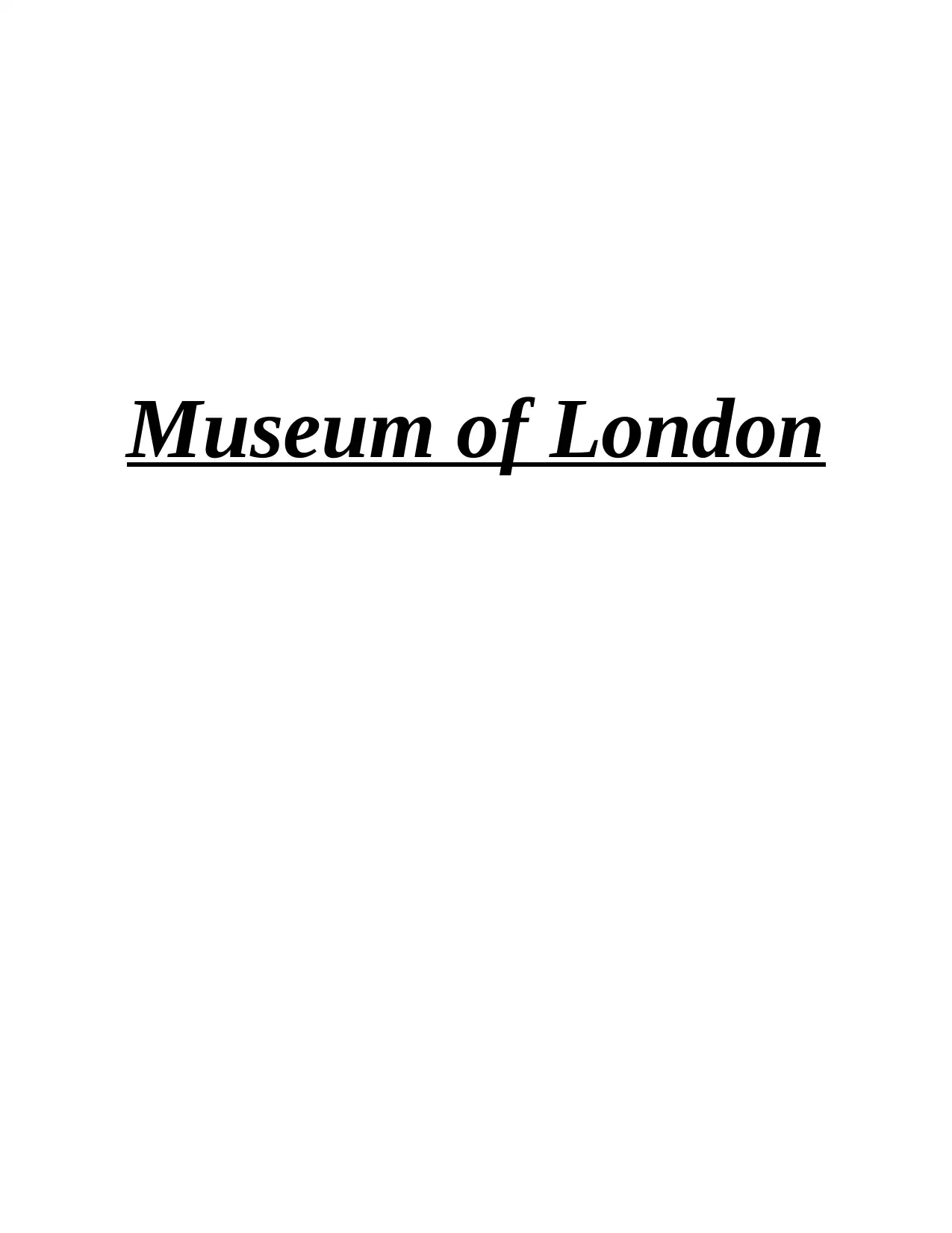
Museum of London
Paraphrase This Document
Need a fresh take? Get an instant paraphrase of this document with our AI Paraphraser
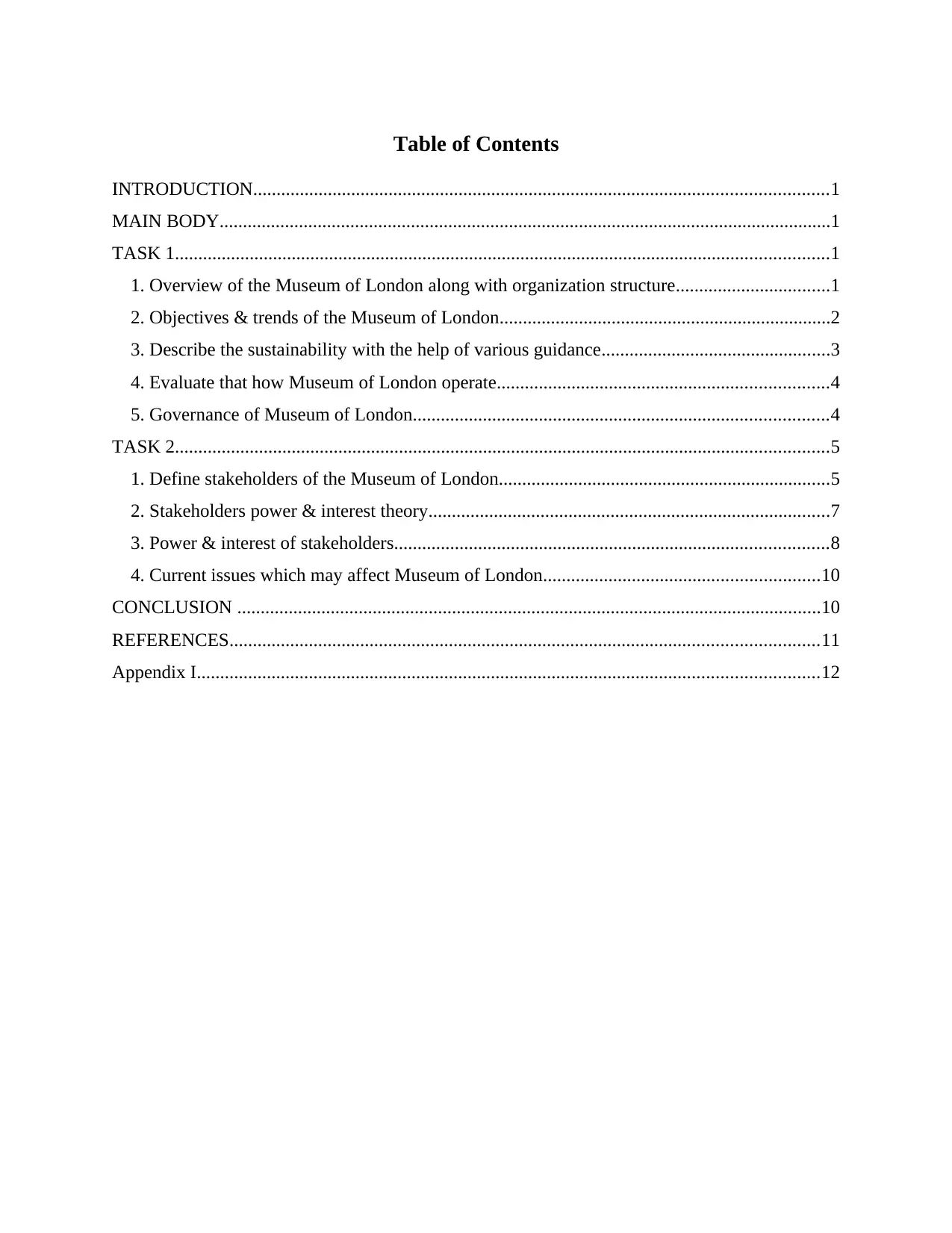
Table of Contents
INTRODUCTION...........................................................................................................................1
MAIN BODY...................................................................................................................................1
TASK 1............................................................................................................................................1
1. Overview of the Museum of London along with organization structure.................................1
2. Objectives & trends of the Museum of London.......................................................................2
3. Describe the sustainability with the help of various guidance.................................................3
4. Evaluate that how Museum of London operate.......................................................................4
5. Governance of Museum of London.........................................................................................4
TASK 2............................................................................................................................................5
1. Define stakeholders of the Museum of London.......................................................................5
2. Stakeholders power & interest theory......................................................................................7
3. Power & interest of stakeholders.............................................................................................8
4. Current issues which may affect Museum of London...........................................................10
CONCLUSION .............................................................................................................................10
REFERENCES..............................................................................................................................11
Appendix I.....................................................................................................................................12
INTRODUCTION...........................................................................................................................1
MAIN BODY...................................................................................................................................1
TASK 1............................................................................................................................................1
1. Overview of the Museum of London along with organization structure.................................1
2. Objectives & trends of the Museum of London.......................................................................2
3. Describe the sustainability with the help of various guidance.................................................3
4. Evaluate that how Museum of London operate.......................................................................4
5. Governance of Museum of London.........................................................................................4
TASK 2............................................................................................................................................5
1. Define stakeholders of the Museum of London.......................................................................5
2. Stakeholders power & interest theory......................................................................................7
3. Power & interest of stakeholders.............................................................................................8
4. Current issues which may affect Museum of London...........................................................10
CONCLUSION .............................................................................................................................10
REFERENCES..............................................................................................................................11
Appendix I.....................................................................................................................................12
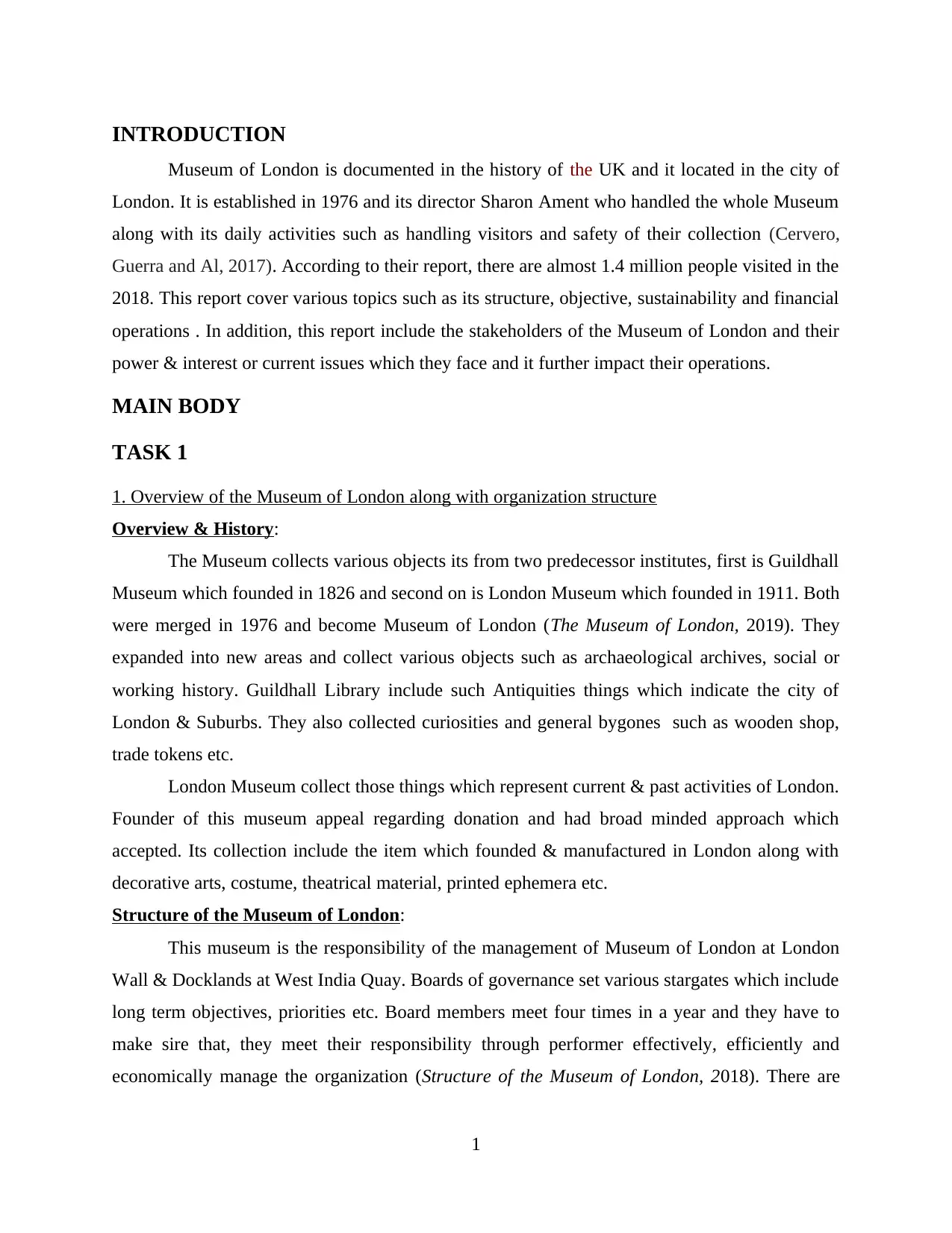
INTRODUCTION
Museum of London is documented in the history of the UK and it located in the city of
London. It is established in 1976 and its director Sharon Ament who handled the whole Museum
along with its daily activities such as handling visitors and safety of their collection (Cervero,
Guerra and Al, 2017). According to their report, there are almost 1.4 million people visited in the
2018. This report cover various topics such as its structure, objective, sustainability and financial
operations . In addition, this report include the stakeholders of the Museum of London and their
power & interest or current issues which they face and it further impact their operations.
MAIN BODY
TASK 1
1. Overview of the Museum of London along with organization structure
Overview & History:
The Museum collects various objects its from two predecessor institutes, first is Guildhall
Museum which founded in 1826 and second on is London Museum which founded in 1911. Both
were merged in 1976 and become Museum of London (The Museum of London, 2019). They
expanded into new areas and collect various objects such as archaeological archives, social or
working history. Guildhall Library include such Antiquities things which indicate the city of
London & Suburbs. They also collected curiosities and general bygones such as wooden shop,
trade tokens etc.
London Museum collect those things which represent current & past activities of London.
Founder of this museum appeal regarding donation and had broad minded approach which
accepted. Its collection include the item which founded & manufactured in London along with
decorative arts, costume, theatrical material, printed ephemera etc.
Structure of the Museum of London:
This museum is the responsibility of the management of Museum of London at London
Wall & Docklands at West India Quay. Boards of governance set various stargates which include
long term objectives, priorities etc. Board members meet four times in a year and they have to
make sire that, they meet their responsibility through performer effectively, efficiently and
economically manage the organization (Structure of the Museum of London, 2018). There are
1
Museum of London is documented in the history of the UK and it located in the city of
London. It is established in 1976 and its director Sharon Ament who handled the whole Museum
along with its daily activities such as handling visitors and safety of their collection (Cervero,
Guerra and Al, 2017). According to their report, there are almost 1.4 million people visited in the
2018. This report cover various topics such as its structure, objective, sustainability and financial
operations . In addition, this report include the stakeholders of the Museum of London and their
power & interest or current issues which they face and it further impact their operations.
MAIN BODY
TASK 1
1. Overview of the Museum of London along with organization structure
Overview & History:
The Museum collects various objects its from two predecessor institutes, first is Guildhall
Museum which founded in 1826 and second on is London Museum which founded in 1911. Both
were merged in 1976 and become Museum of London (The Museum of London, 2019). They
expanded into new areas and collect various objects such as archaeological archives, social or
working history. Guildhall Library include such Antiquities things which indicate the city of
London & Suburbs. They also collected curiosities and general bygones such as wooden shop,
trade tokens etc.
London Museum collect those things which represent current & past activities of London.
Founder of this museum appeal regarding donation and had broad minded approach which
accepted. Its collection include the item which founded & manufactured in London along with
decorative arts, costume, theatrical material, printed ephemera etc.
Structure of the Museum of London:
This museum is the responsibility of the management of Museum of London at London
Wall & Docklands at West India Quay. Boards of governance set various stargates which include
long term objectives, priorities etc. Board members meet four times in a year and they have to
make sire that, they meet their responsibility through performer effectively, efficiently and
economically manage the organization (Structure of the Museum of London, 2018). There are
1
⊘ This is a preview!⊘
Do you want full access?
Subscribe today to unlock all pages.

Trusted by 1+ million students worldwide
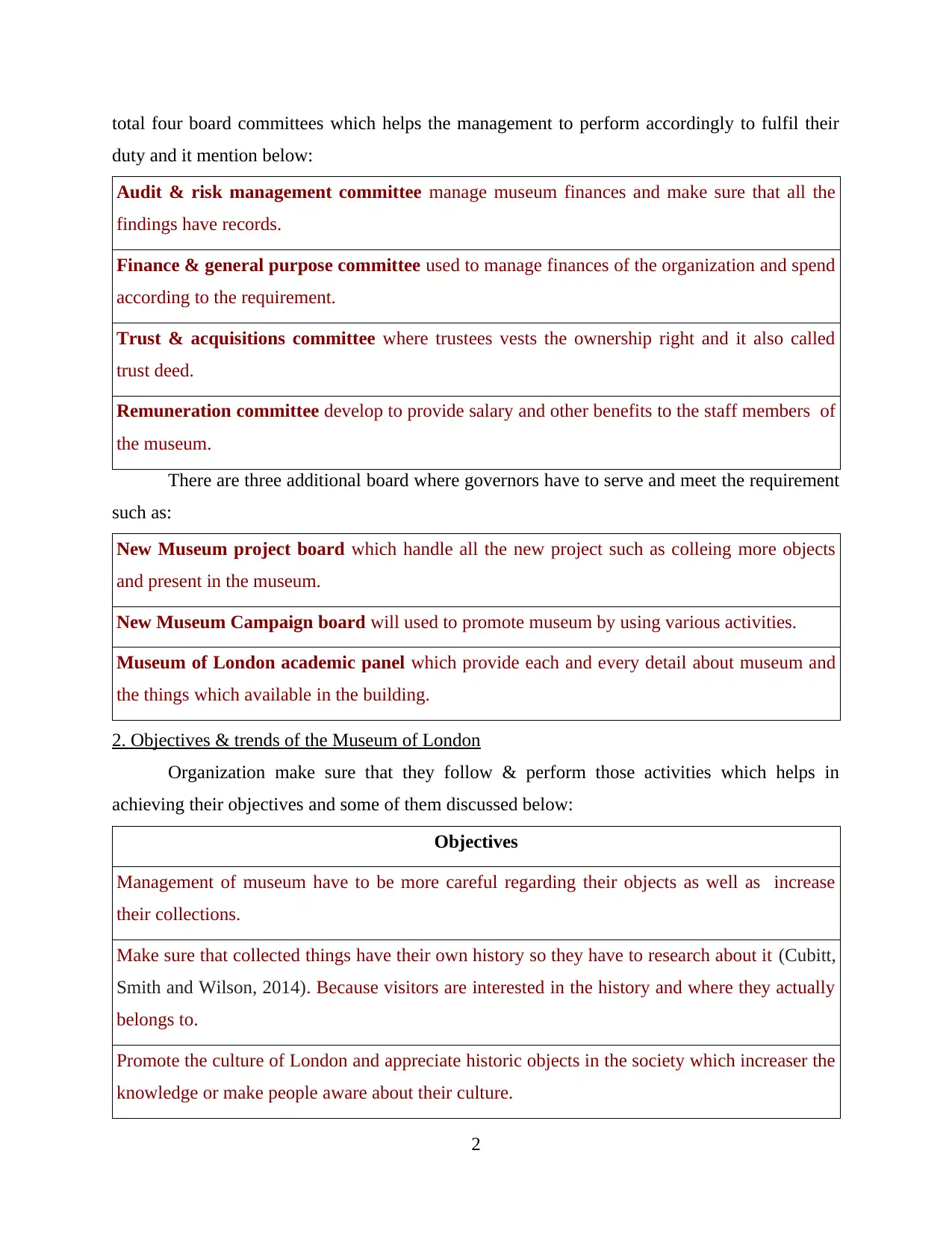
total four board committees which helps the management to perform accordingly to fulfil their
duty and it mention below:
Audit & risk management committee manage museum finances and make sure that all the
findings have records.
Finance & general purpose committee used to manage finances of the organization and spend
according to the requirement.
Trust & acquisitions committee where trustees vests the ownership right and it also called
trust deed.
Remuneration committee develop to provide salary and other benefits to the staff members of
the museum.
There are three additional board where governors have to serve and meet the requirement
such as:
New Museum project board which handle all the new project such as colleing more objects
and present in the museum.
New Museum Campaign board will used to promote museum by using various activities.
Museum of London academic panel which provide each and every detail about museum and
the things which available in the building.
2. Objectives & trends of the Museum of London
Organization make sure that they follow & perform those activities which helps in
achieving their objectives and some of them discussed below:
Objectives
Management of museum have to be more careful regarding their objects as well as increase
their collections.
Make sure that collected things have their own history so they have to research about it (Cubitt,
Smith and Wilson, 2014). Because visitors are interested in the history and where they actually
belongs to.
Promote the culture of London and appreciate historic objects in the society which increaser the
knowledge or make people aware about their culture.
2
duty and it mention below:
Audit & risk management committee manage museum finances and make sure that all the
findings have records.
Finance & general purpose committee used to manage finances of the organization and spend
according to the requirement.
Trust & acquisitions committee where trustees vests the ownership right and it also called
trust deed.
Remuneration committee develop to provide salary and other benefits to the staff members of
the museum.
There are three additional board where governors have to serve and meet the requirement
such as:
New Museum project board which handle all the new project such as colleing more objects
and present in the museum.
New Museum Campaign board will used to promote museum by using various activities.
Museum of London academic panel which provide each and every detail about museum and
the things which available in the building.
2. Objectives & trends of the Museum of London
Organization make sure that they follow & perform those activities which helps in
achieving their objectives and some of them discussed below:
Objectives
Management of museum have to be more careful regarding their objects as well as increase
their collections.
Make sure that collected things have their own history so they have to research about it (Cubitt,
Smith and Wilson, 2014). Because visitors are interested in the history and where they actually
belongs to.
Promote the culture of London and appreciate historic objects in the society which increaser the
knowledge or make people aware about their culture.
2
Paraphrase This Document
Need a fresh take? Get an instant paraphrase of this document with our AI Paraphraser
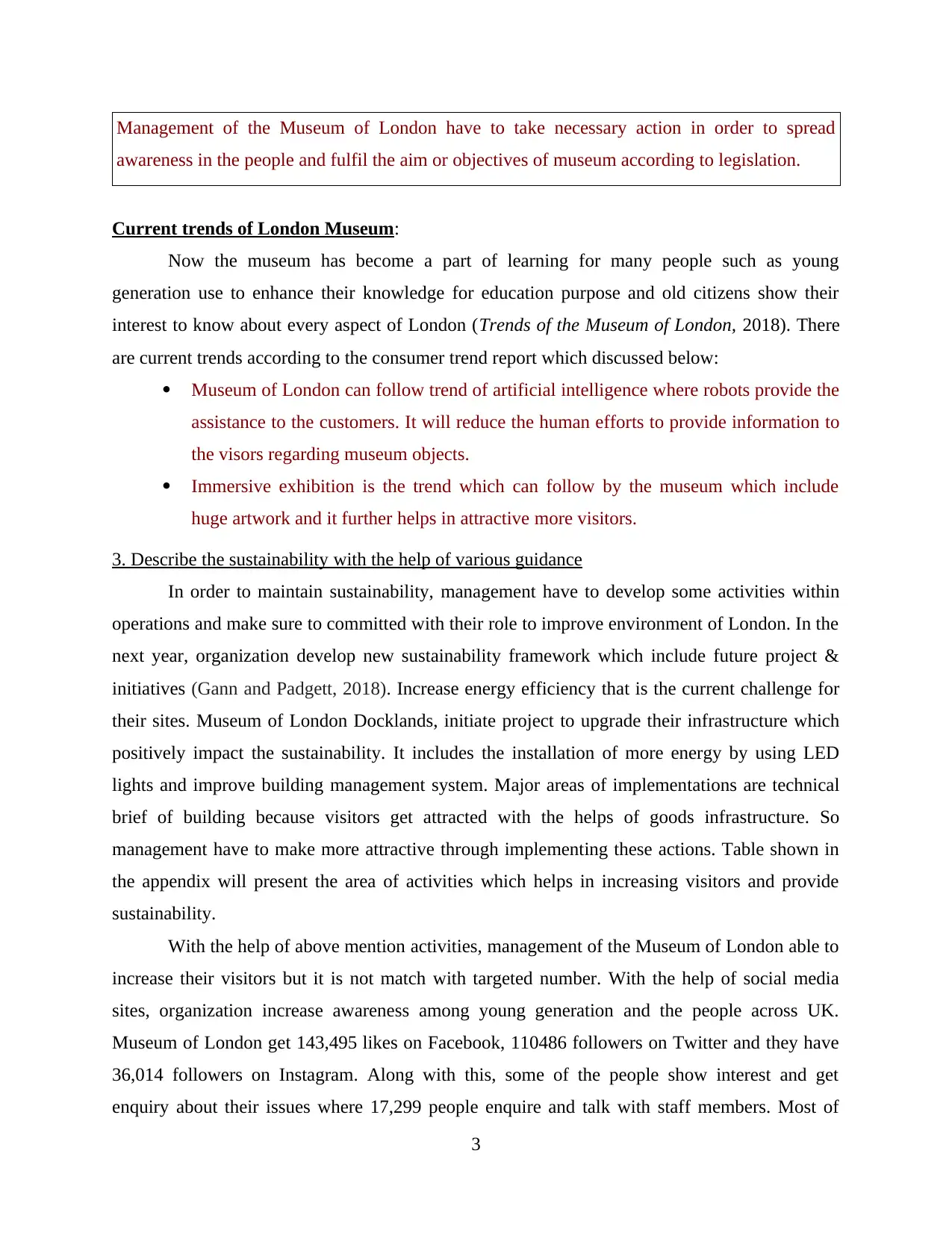
Management of the Museum of London have to take necessary action in order to spread
awareness in the people and fulfil the aim or objectives of museum according to legislation.
Current trends of London Museum:
Now the museum has become a part of learning for many people such as young
generation use to enhance their knowledge for education purpose and old citizens show their
interest to know about every aspect of London (Trends of the Museum of London, 2018). There
are current trends according to the consumer trend report which discussed below:
Museum of London can follow trend of artificial intelligence where robots provide the
assistance to the customers. It will reduce the human efforts to provide information to
the visors regarding museum objects.
Immersive exhibition is the trend which can follow by the museum which include
huge artwork and it further helps in attractive more visitors.
3. Describe the sustainability with the help of various guidance
In order to maintain sustainability, management have to develop some activities within
operations and make sure to committed with their role to improve environment of London. In the
next year, organization develop new sustainability framework which include future project &
initiatives (Gann and Padgett, 2018). Increase energy efficiency that is the current challenge for
their sites. Museum of London Docklands, initiate project to upgrade their infrastructure which
positively impact the sustainability. It includes the installation of more energy by using LED
lights and improve building management system. Major areas of implementations are technical
brief of building because visitors get attracted with the helps of goods infrastructure. So
management have to make more attractive through implementing these actions. Table shown in
the appendix will present the area of activities which helps in increasing visitors and provide
sustainability.
With the help of above mention activities, management of the Museum of London able to
increase their visitors but it is not match with targeted number. With the help of social media
sites, organization increase awareness among young generation and the people across UK.
Museum of London get 143,495 likes on Facebook, 110486 followers on Twitter and they have
36,014 followers on Instagram. Along with this, some of the people show interest and get
enquiry about their issues where 17,299 people enquire and talk with staff members. Most of
3
awareness in the people and fulfil the aim or objectives of museum according to legislation.
Current trends of London Museum:
Now the museum has become a part of learning for many people such as young
generation use to enhance their knowledge for education purpose and old citizens show their
interest to know about every aspect of London (Trends of the Museum of London, 2018). There
are current trends according to the consumer trend report which discussed below:
Museum of London can follow trend of artificial intelligence where robots provide the
assistance to the customers. It will reduce the human efforts to provide information to
the visors regarding museum objects.
Immersive exhibition is the trend which can follow by the museum which include
huge artwork and it further helps in attractive more visitors.
3. Describe the sustainability with the help of various guidance
In order to maintain sustainability, management have to develop some activities within
operations and make sure to committed with their role to improve environment of London. In the
next year, organization develop new sustainability framework which include future project &
initiatives (Gann and Padgett, 2018). Increase energy efficiency that is the current challenge for
their sites. Museum of London Docklands, initiate project to upgrade their infrastructure which
positively impact the sustainability. It includes the installation of more energy by using LED
lights and improve building management system. Major areas of implementations are technical
brief of building because visitors get attracted with the helps of goods infrastructure. So
management have to make more attractive through implementing these actions. Table shown in
the appendix will present the area of activities which helps in increasing visitors and provide
sustainability.
With the help of above mention activities, management of the Museum of London able to
increase their visitors but it is not match with targeted number. With the help of social media
sites, organization increase awareness among young generation and the people across UK.
Museum of London get 143,495 likes on Facebook, 110486 followers on Twitter and they have
36,014 followers on Instagram. Along with this, some of the people show interest and get
enquiry about their issues where 17,299 people enquire and talk with staff members. Most of
3
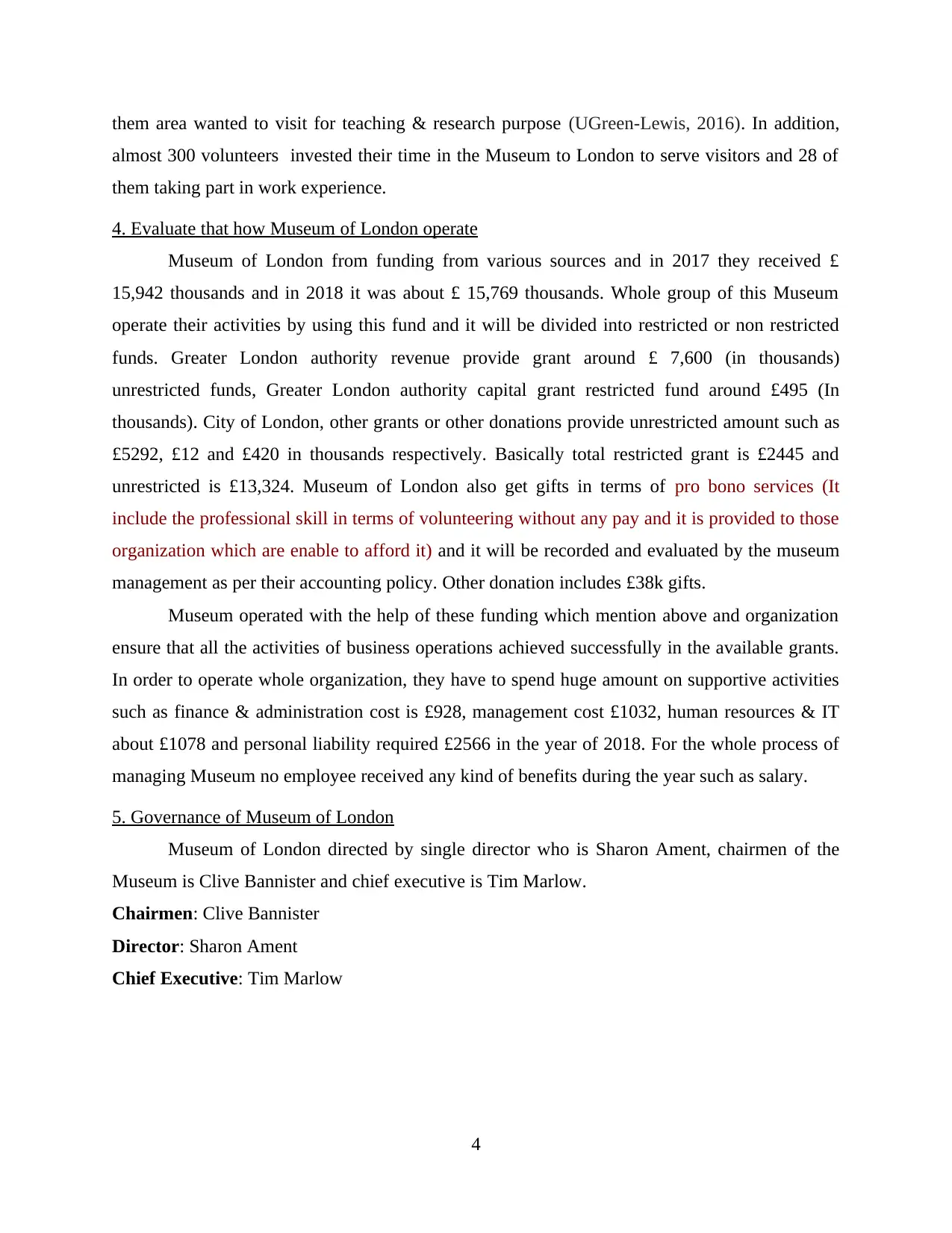
them area wanted to visit for teaching & research purpose (UGreen-Lewis, 2016). In addition,
almost 300 volunteers invested their time in the Museum to London to serve visitors and 28 of
them taking part in work experience.
4. Evaluate that how Museum of London operate
Museum of London from funding from various sources and in 2017 they received £
15,942 thousands and in 2018 it was about £ 15,769 thousands. Whole group of this Museum
operate their activities by using this fund and it will be divided into restricted or non restricted
funds. Greater London authority revenue provide grant around £ 7,600 (in thousands)
unrestricted funds, Greater London authority capital grant restricted fund around £495 (In
thousands). City of London, other grants or other donations provide unrestricted amount such as
£5292, £12 and £420 in thousands respectively. Basically total restricted grant is £2445 and
unrestricted is £13,324. Museum of London also get gifts in terms of pro bono services (It
include the professional skill in terms of volunteering without any pay and it is provided to those
organization which are enable to afford it) and it will be recorded and evaluated by the museum
management as per their accounting policy. Other donation includes £38k gifts.
Museum operated with the help of these funding which mention above and organization
ensure that all the activities of business operations achieved successfully in the available grants.
In order to operate whole organization, they have to spend huge amount on supportive activities
such as finance & administration cost is £928, management cost £1032, human resources & IT
about £1078 and personal liability required £2566 in the year of 2018. For the whole process of
managing Museum no employee received any kind of benefits during the year such as salary.
5. Governance of Museum of London
Museum of London directed by single director who is Sharon Ament, chairmen of the
Museum is Clive Bannister and chief executive is Tim Marlow.
Chairmen: Clive Bannister
Director: Sharon Ament
Chief Executive: Tim Marlow
4
almost 300 volunteers invested their time in the Museum to London to serve visitors and 28 of
them taking part in work experience.
4. Evaluate that how Museum of London operate
Museum of London from funding from various sources and in 2017 they received £
15,942 thousands and in 2018 it was about £ 15,769 thousands. Whole group of this Museum
operate their activities by using this fund and it will be divided into restricted or non restricted
funds. Greater London authority revenue provide grant around £ 7,600 (in thousands)
unrestricted funds, Greater London authority capital grant restricted fund around £495 (In
thousands). City of London, other grants or other donations provide unrestricted amount such as
£5292, £12 and £420 in thousands respectively. Basically total restricted grant is £2445 and
unrestricted is £13,324. Museum of London also get gifts in terms of pro bono services (It
include the professional skill in terms of volunteering without any pay and it is provided to those
organization which are enable to afford it) and it will be recorded and evaluated by the museum
management as per their accounting policy. Other donation includes £38k gifts.
Museum operated with the help of these funding which mention above and organization
ensure that all the activities of business operations achieved successfully in the available grants.
In order to operate whole organization, they have to spend huge amount on supportive activities
such as finance & administration cost is £928, management cost £1032, human resources & IT
about £1078 and personal liability required £2566 in the year of 2018. For the whole process of
managing Museum no employee received any kind of benefits during the year such as salary.
5. Governance of Museum of London
Museum of London directed by single director who is Sharon Ament, chairmen of the
Museum is Clive Bannister and chief executive is Tim Marlow.
Chairmen: Clive Bannister
Director: Sharon Ament
Chief Executive: Tim Marlow
4
⊘ This is a preview!⊘
Do you want full access?
Subscribe today to unlock all pages.

Trusted by 1+ million students worldwide
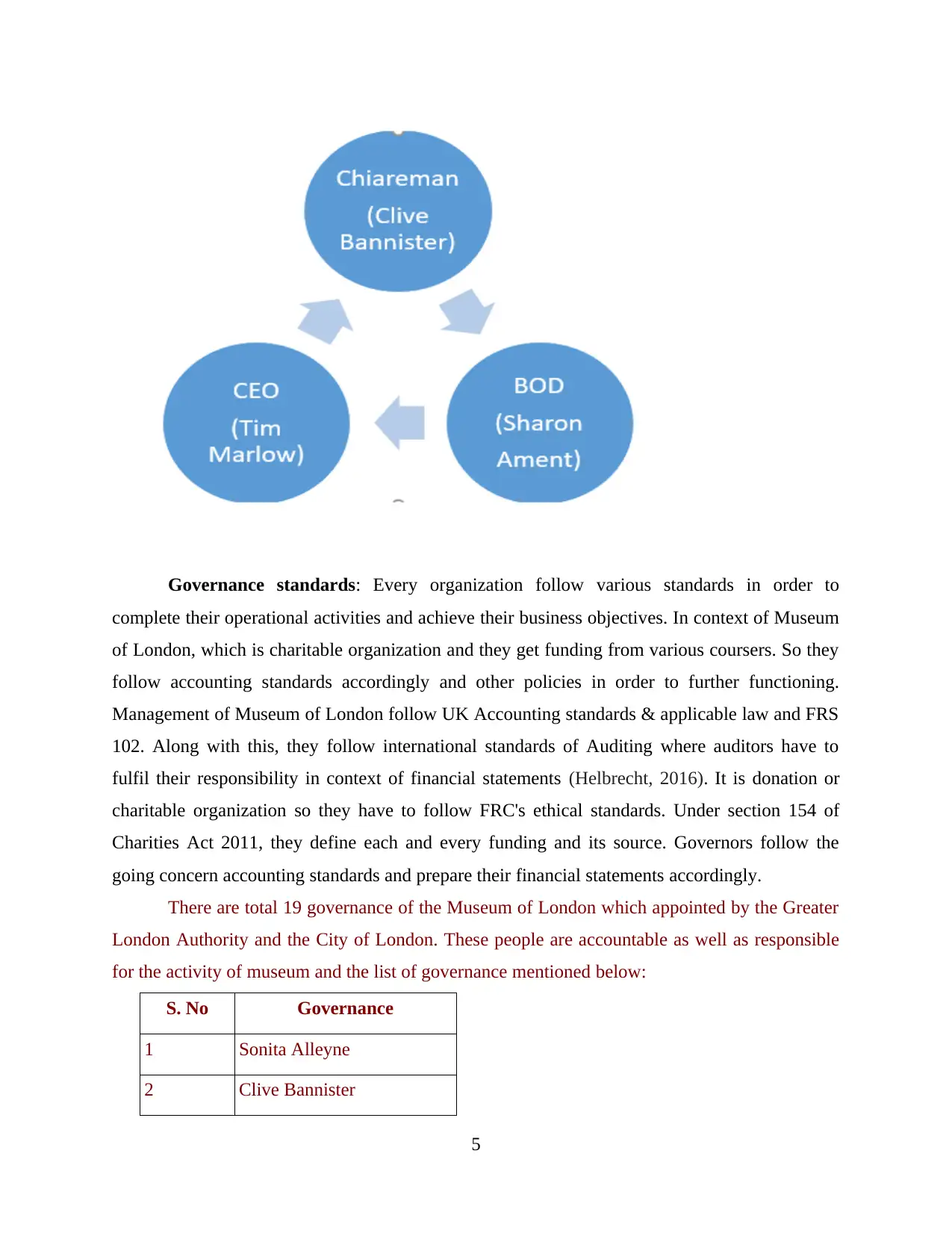
Governance standards: Every organization follow various standards in order to
complete their operational activities and achieve their business objectives. In context of Museum
of London, which is charitable organization and they get funding from various coursers. So they
follow accounting standards accordingly and other policies in order to further functioning.
Management of Museum of London follow UK Accounting standards & applicable law and FRS
102. Along with this, they follow international standards of Auditing where auditors have to
fulfil their responsibility in context of financial statements (Helbrecht, 2016). It is donation or
charitable organization so they have to follow FRC's ethical standards. Under section 154 of
Charities Act 2011, they define each and every funding and its source. Governors follow the
going concern accounting standards and prepare their financial statements accordingly.
There are total 19 governance of the Museum of London which appointed by the Greater
London Authority and the City of London. These people are accountable as well as responsible
for the activity of museum and the list of governance mentioned below:
S. No Governance
1 Sonita Alleyne
2 Clive Bannister
5
complete their operational activities and achieve their business objectives. In context of Museum
of London, which is charitable organization and they get funding from various coursers. So they
follow accounting standards accordingly and other policies in order to further functioning.
Management of Museum of London follow UK Accounting standards & applicable law and FRS
102. Along with this, they follow international standards of Auditing where auditors have to
fulfil their responsibility in context of financial statements (Helbrecht, 2016). It is donation or
charitable organization so they have to follow FRC's ethical standards. Under section 154 of
Charities Act 2011, they define each and every funding and its source. Governors follow the
going concern accounting standards and prepare their financial statements accordingly.
There are total 19 governance of the Museum of London which appointed by the Greater
London Authority and the City of London. These people are accountable as well as responsible
for the activity of museum and the list of governance mentioned below:
S. No Governance
1 Sonita Alleyne
2 Clive Bannister
5
Paraphrase This Document
Need a fresh take? Get an instant paraphrase of this document with our AI Paraphraser
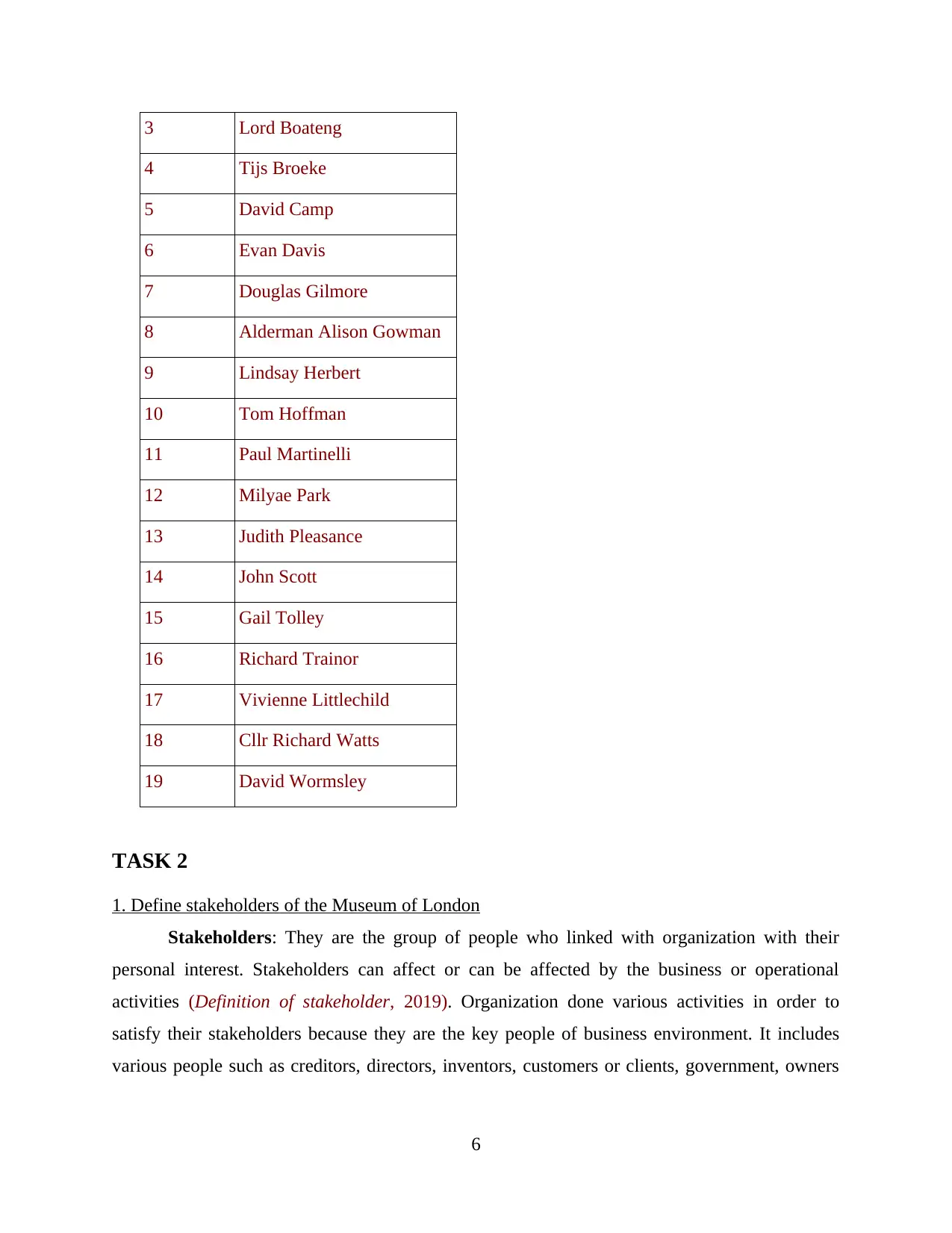
3 Lord Boateng
4 Tijs Broeke
5 David Camp
6 Evan Davis
7 Douglas Gilmore
8 Alderman Alison Gowman
9 Lindsay Herbert
10 Tom Hoffman
11 Paul Martinelli
12 Milyae Park
13 Judith Pleasance
14 John Scott
15 Gail Tolley
16 Richard Trainor
17 Vivienne Littlechild
18 Cllr Richard Watts
19 David Wormsley
TASK 2
1. Define stakeholders of the Museum of London
Stakeholders: They are the group of people who linked with organization with their
personal interest. Stakeholders can affect or can be affected by the business or operational
activities (Definition of stakeholder, 2019). Organization done various activities in order to
satisfy their stakeholders because they are the key people of business environment. It includes
various people such as creditors, directors, inventors, customers or clients, government, owners
6
4 Tijs Broeke
5 David Camp
6 Evan Davis
7 Douglas Gilmore
8 Alderman Alison Gowman
9 Lindsay Herbert
10 Tom Hoffman
11 Paul Martinelli
12 Milyae Park
13 Judith Pleasance
14 John Scott
15 Gail Tolley
16 Richard Trainor
17 Vivienne Littlechild
18 Cllr Richard Watts
19 David Wormsley
TASK 2
1. Define stakeholders of the Museum of London
Stakeholders: They are the group of people who linked with organization with their
personal interest. Stakeholders can affect or can be affected by the business or operational
activities (Definition of stakeholder, 2019). Organization done various activities in order to
satisfy their stakeholders because they are the key people of business environment. It includes
various people such as creditors, directors, inventors, customers or clients, government, owners
6
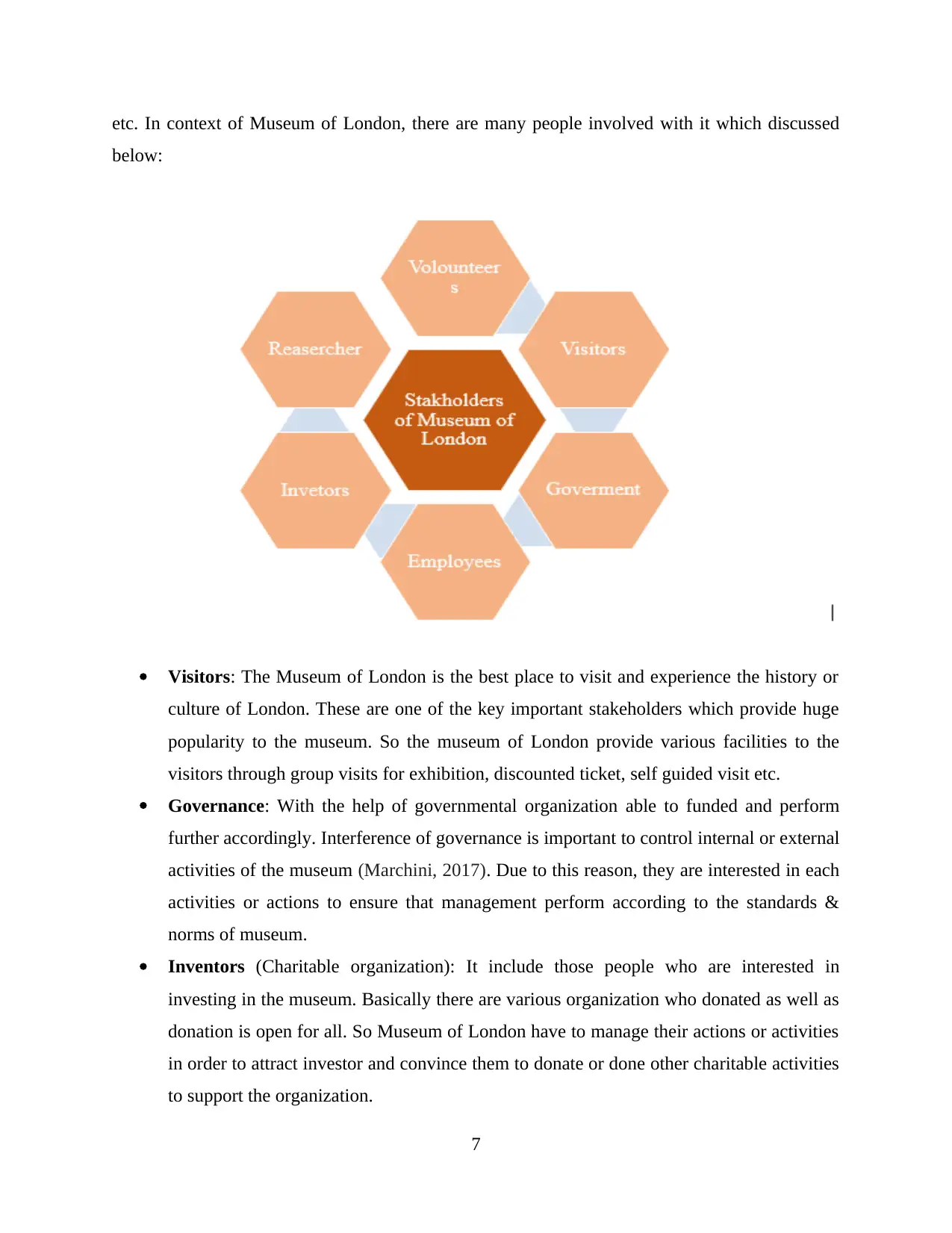
etc. In context of Museum of London, there are many people involved with it which discussed
below:
Visitors: The Museum of London is the best place to visit and experience the history or
culture of London. These are one of the key important stakeholders which provide huge
popularity to the museum. So the museum of London provide various facilities to the
visitors through group visits for exhibition, discounted ticket, self guided visit etc.
Governance: With the help of governmental organization able to funded and perform
further accordingly. Interference of governance is important to control internal or external
activities of the museum (Marchini, 2017). Due to this reason, they are interested in each
activities or actions to ensure that management perform according to the standards &
norms of museum.
Inventors (Charitable organization): It include those people who are interested in
investing in the museum. Basically there are various organization who donated as well as
donation is open for all. So Museum of London have to manage their actions or activities
in order to attract investor and convince them to donate or done other charitable activities
to support the organization.
7
below:
Visitors: The Museum of London is the best place to visit and experience the history or
culture of London. These are one of the key important stakeholders which provide huge
popularity to the museum. So the museum of London provide various facilities to the
visitors through group visits for exhibition, discounted ticket, self guided visit etc.
Governance: With the help of governmental organization able to funded and perform
further accordingly. Interference of governance is important to control internal or external
activities of the museum (Marchini, 2017). Due to this reason, they are interested in each
activities or actions to ensure that management perform according to the standards &
norms of museum.
Inventors (Charitable organization): It include those people who are interested in
investing in the museum. Basically there are various organization who donated as well as
donation is open for all. So Museum of London have to manage their actions or activities
in order to attract investor and convince them to donate or done other charitable activities
to support the organization.
7
⊘ This is a preview!⊘
Do you want full access?
Subscribe today to unlock all pages.

Trusted by 1+ million students worldwide
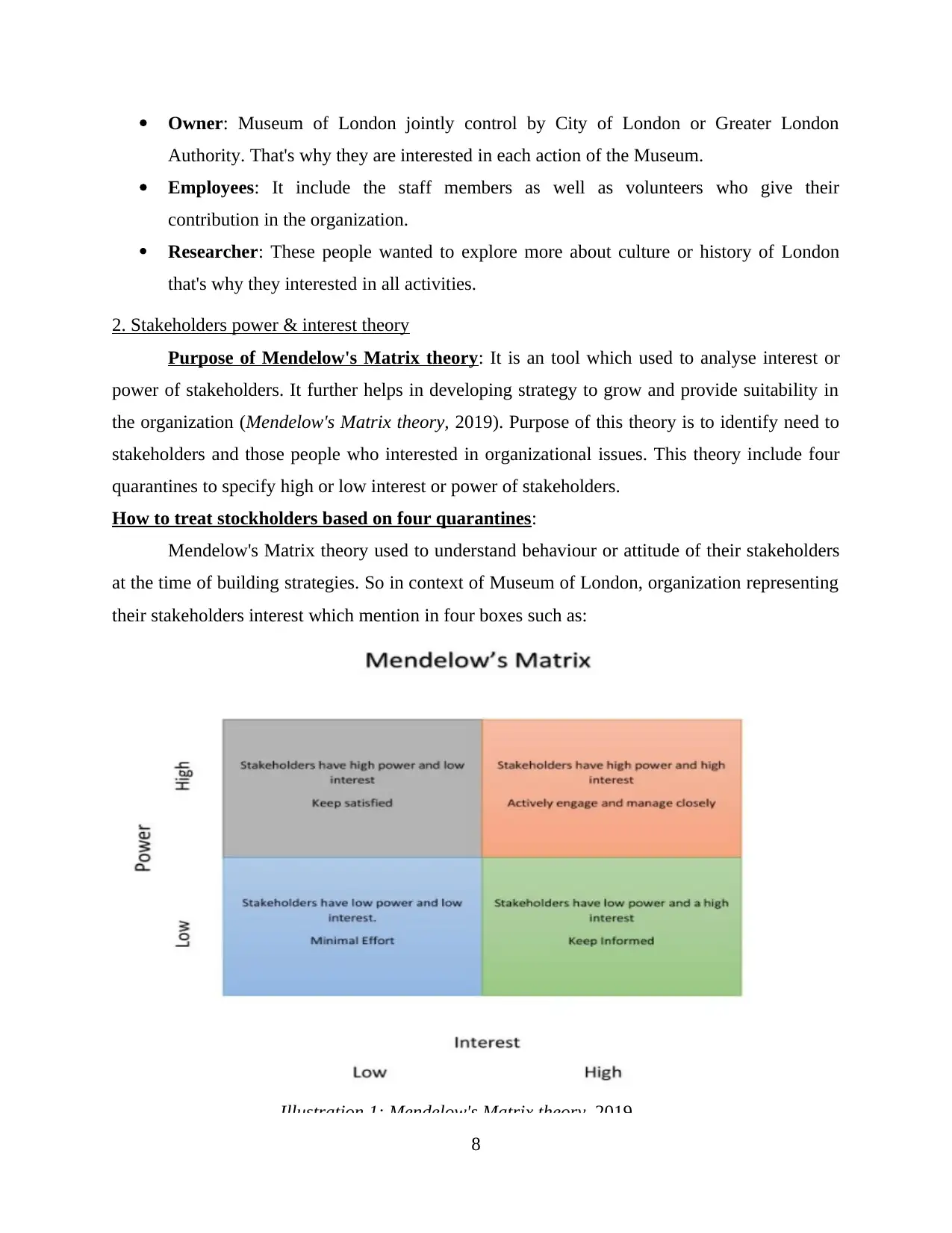
Owner: Museum of London jointly control by City of London or Greater London
Authority. That's why they are interested in each action of the Museum.
Employees: It include the staff members as well as volunteers who give their
contribution in the organization.
Researcher: These people wanted to explore more about culture or history of London
that's why they interested in all activities.
2. Stakeholders power & interest theory
Purpose of Mendelow's Matrix theory: It is an tool which used to analyse interest or
power of stakeholders. It further helps in developing strategy to grow and provide suitability in
the organization (Mendelow's Matrix theory, 2019). Purpose of this theory is to identify need to
stakeholders and those people who interested in organizational issues. This theory include four
quarantines to specify high or low interest or power of stakeholders.
How to treat stockholders based on four quarantines:
Mendelow's Matrix theory used to understand behaviour or attitude of their stakeholders
at the time of building strategies. So in context of Museum of London, organization representing
their stakeholders interest which mention in four boxes such as:
Illustration 1: Mendelow's Matrix theory, 2019.
8
Authority. That's why they are interested in each action of the Museum.
Employees: It include the staff members as well as volunteers who give their
contribution in the organization.
Researcher: These people wanted to explore more about culture or history of London
that's why they interested in all activities.
2. Stakeholders power & interest theory
Purpose of Mendelow's Matrix theory: It is an tool which used to analyse interest or
power of stakeholders. It further helps in developing strategy to grow and provide suitability in
the organization (Mendelow's Matrix theory, 2019). Purpose of this theory is to identify need to
stakeholders and those people who interested in organizational issues. This theory include four
quarantines to specify high or low interest or power of stakeholders.
How to treat stockholders based on four quarantines:
Mendelow's Matrix theory used to understand behaviour or attitude of their stakeholders
at the time of building strategies. So in context of Museum of London, organization representing
their stakeholders interest which mention in four boxes such as:
Illustration 1: Mendelow's Matrix theory, 2019.
8
Paraphrase This Document
Need a fresh take? Get an instant paraphrase of this document with our AI Paraphraser
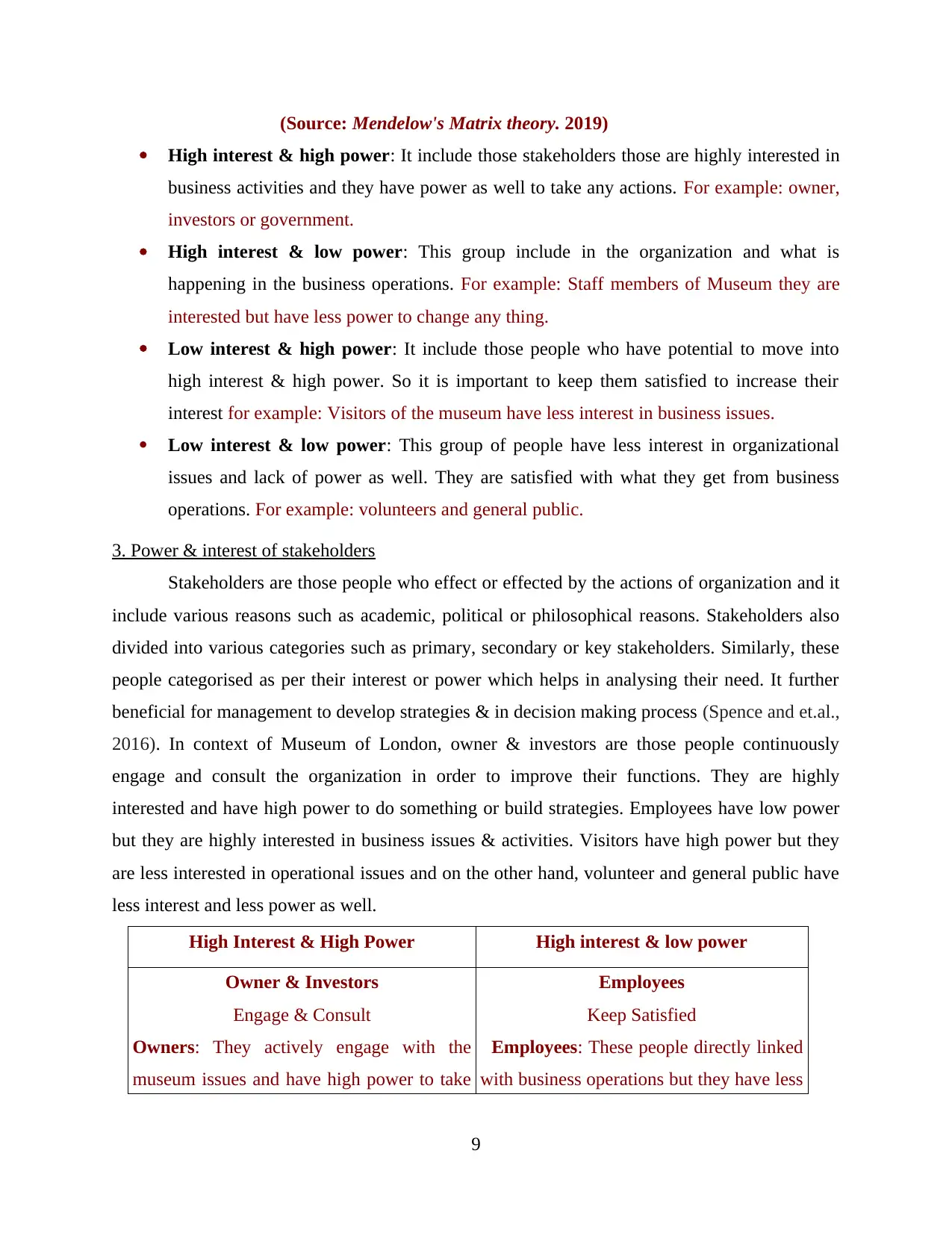
(Source: Mendelow's Matrix theory. 2019)
High interest & high power: It include those stakeholders those are highly interested in
business activities and they have power as well to take any actions. For example: owner,
investors or government.
High interest & low power: This group include in the organization and what is
happening in the business operations. For example: Staff members of Museum they are
interested but have less power to change any thing.
Low interest & high power: It include those people who have potential to move into
high interest & high power. So it is important to keep them satisfied to increase their
interest for example: Visitors of the museum have less interest in business issues.
Low interest & low power: This group of people have less interest in organizational
issues and lack of power as well. They are satisfied with what they get from business
operations. For example: volunteers and general public.
3. Power & interest of stakeholders
Stakeholders are those people who effect or effected by the actions of organization and it
include various reasons such as academic, political or philosophical reasons. Stakeholders also
divided into various categories such as primary, secondary or key stakeholders. Similarly, these
people categorised as per their interest or power which helps in analysing their need. It further
beneficial for management to develop strategies & in decision making process (Spence and et.al.,
2016). In context of Museum of London, owner & investors are those people continuously
engage and consult the organization in order to improve their functions. They are highly
interested and have high power to do something or build strategies. Employees have low power
but they are highly interested in business issues & activities. Visitors have high power but they
are less interested in operational issues and on the other hand, volunteer and general public have
less interest and less power as well.
High Interest & High Power High interest & low power
Owner & Investors
Engage & Consult
Owners: They actively engage with the
museum issues and have high power to take
Employees
Keep Satisfied
Employees: These people directly linked
with business operations but they have less
9
High interest & high power: It include those stakeholders those are highly interested in
business activities and they have power as well to take any actions. For example: owner,
investors or government.
High interest & low power: This group include in the organization and what is
happening in the business operations. For example: Staff members of Museum they are
interested but have less power to change any thing.
Low interest & high power: It include those people who have potential to move into
high interest & high power. So it is important to keep them satisfied to increase their
interest for example: Visitors of the museum have less interest in business issues.
Low interest & low power: This group of people have less interest in organizational
issues and lack of power as well. They are satisfied with what they get from business
operations. For example: volunteers and general public.
3. Power & interest of stakeholders
Stakeholders are those people who effect or effected by the actions of organization and it
include various reasons such as academic, political or philosophical reasons. Stakeholders also
divided into various categories such as primary, secondary or key stakeholders. Similarly, these
people categorised as per their interest or power which helps in analysing their need. It further
beneficial for management to develop strategies & in decision making process (Spence and et.al.,
2016). In context of Museum of London, owner & investors are those people continuously
engage and consult the organization in order to improve their functions. They are highly
interested and have high power to do something or build strategies. Employees have low power
but they are highly interested in business issues & activities. Visitors have high power but they
are less interested in operational issues and on the other hand, volunteer and general public have
less interest and less power as well.
High Interest & High Power High interest & low power
Owner & Investors
Engage & Consult
Owners: They actively engage with the
museum issues and have high power to take
Employees
Keep Satisfied
Employees: These people directly linked
with business operations but they have less
9
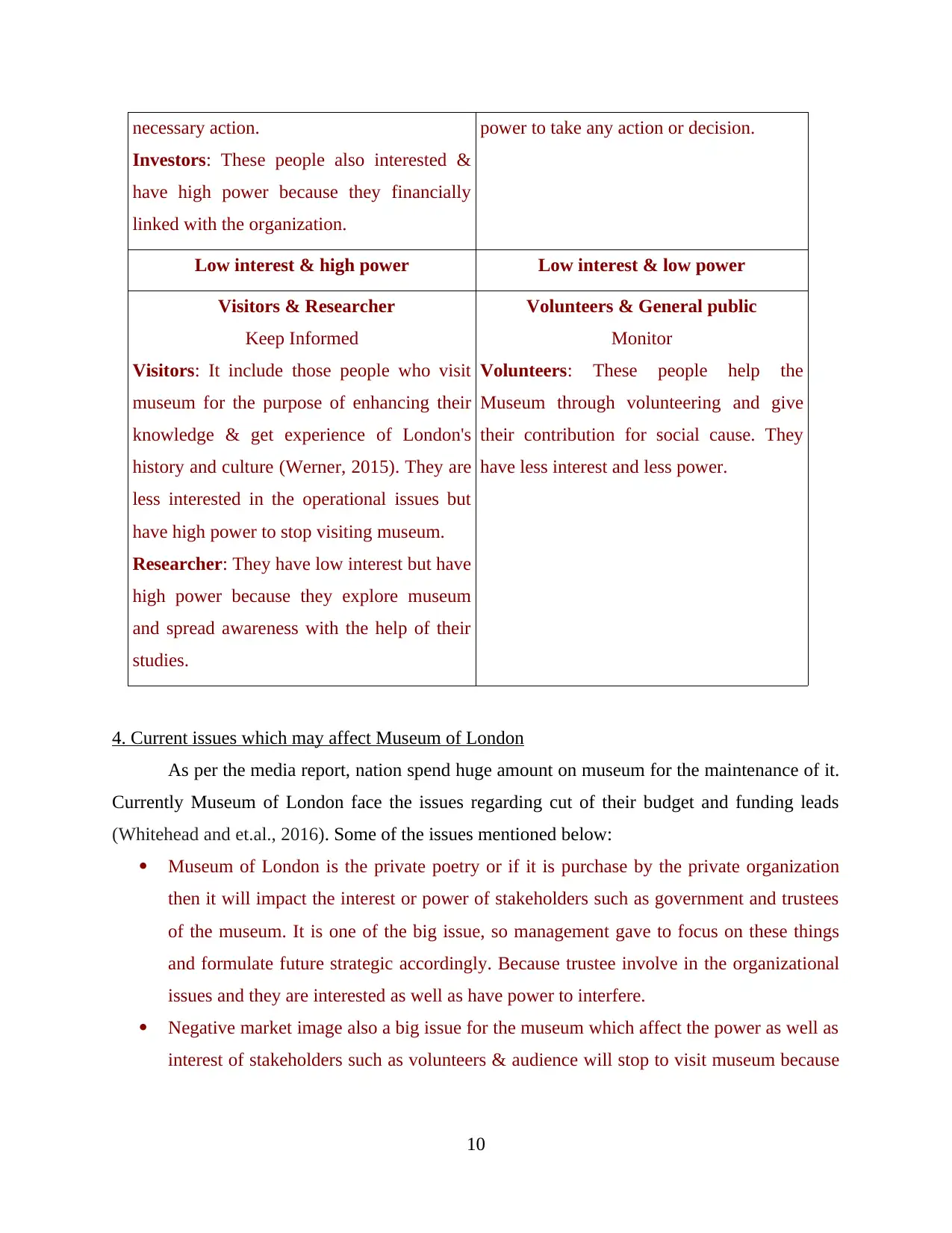
necessary action.
Investors: These people also interested &
have high power because they financially
linked with the organization.
power to take any action or decision.
Low interest & high power Low interest & low power
Visitors & Researcher
Keep Informed
Visitors: It include those people who visit
museum for the purpose of enhancing their
knowledge & get experience of London's
history and culture (Werner, 2015). They are
less interested in the operational issues but
have high power to stop visiting museum.
Researcher: They have low interest but have
high power because they explore museum
and spread awareness with the help of their
studies.
Volunteers & General public
Monitor
Volunteers: These people help the
Museum through volunteering and give
their contribution for social cause. They
have less interest and less power.
4. Current issues which may affect Museum of London
As per the media report, nation spend huge amount on museum for the maintenance of it.
Currently Museum of London face the issues regarding cut of their budget and funding leads
(Whitehead and et.al., 2016). Some of the issues mentioned below:
Museum of London is the private poetry or if it is purchase by the private organization
then it will impact the interest or power of stakeholders such as government and trustees
of the museum. It is one of the big issue, so management gave to focus on these things
and formulate future strategic accordingly. Because trustee involve in the organizational
issues and they are interested as well as have power to interfere.
Negative market image also a big issue for the museum which affect the power as well as
interest of stakeholders such as volunteers & audience will stop to visit museum because
10
Investors: These people also interested &
have high power because they financially
linked with the organization.
power to take any action or decision.
Low interest & high power Low interest & low power
Visitors & Researcher
Keep Informed
Visitors: It include those people who visit
museum for the purpose of enhancing their
knowledge & get experience of London's
history and culture (Werner, 2015). They are
less interested in the operational issues but
have high power to stop visiting museum.
Researcher: They have low interest but have
high power because they explore museum
and spread awareness with the help of their
studies.
Volunteers & General public
Monitor
Volunteers: These people help the
Museum through volunteering and give
their contribution for social cause. They
have less interest and less power.
4. Current issues which may affect Museum of London
As per the media report, nation spend huge amount on museum for the maintenance of it.
Currently Museum of London face the issues regarding cut of their budget and funding leads
(Whitehead and et.al., 2016). Some of the issues mentioned below:
Museum of London is the private poetry or if it is purchase by the private organization
then it will impact the interest or power of stakeholders such as government and trustees
of the museum. It is one of the big issue, so management gave to focus on these things
and formulate future strategic accordingly. Because trustee involve in the organizational
issues and they are interested as well as have power to interfere.
Negative market image also a big issue for the museum which affect the power as well as
interest of stakeholders such as volunteers & audience will stop to visit museum because
10
⊘ This is a preview!⊘
Do you want full access?
Subscribe today to unlock all pages.

Trusted by 1+ million students worldwide
1 out of 15
Related Documents
Your All-in-One AI-Powered Toolkit for Academic Success.
+13062052269
info@desklib.com
Available 24*7 on WhatsApp / Email
![[object Object]](/_next/static/media/star-bottom.7253800d.svg)
Unlock your academic potential
Copyright © 2020–2025 A2Z Services. All Rights Reserved. Developed and managed by ZUCOL.





